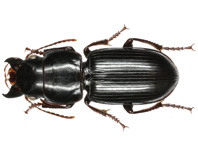Abstract
The psocidiid Hypopsylla belmontensis gen. et sp. nov., new psocidiid genus and species, is described and figured from the Late Permian of New South Wales in Australia. This discovery extends the knowledge on the diversity of the small order Permopsocida whose members passed the Permian-Triassic boundary and became extinct in Cretaceous.
References
Ansorge, J. (1996) Insekten aus dem Oberen Lias von Grimmen (Vorpommern, Norddeutschland). Neue Paläontologische Abhandlungen, 2, 1–132.
Carpenter, F.M. (1992) Treatise on Invertebrate Paleontology, Part R, Arthropoda 4. Geological Society of America Inc, Boulder, 655 pp.
Huang, Di-Ying, Bechly, G., Nel, P., Engel, M.S., Prokop, J., Azar, D., Cai, Chen-Yang, van de Kamp, T., Staniczek, A.H., Garrouste, R., Krogmann, L., dos Santos Rolo, T., Baumbach, T., Olhoff, R., Shmakov, A.S., Bourgoin, T. & Nel, A. (2016) New fossil insect order Permopsocida elucidates major radiation and evolution of suction feeding in hemimetabolous insects (Hexapoda: Acercaria). Scientific Reports, 6 (23004), 1–9.
http://dx.doi.org/10.1038/srep23004Liang, Feiyang, Zhang, Weiwei & Liu, Xingyue (2016) A new genus and species of the paraneopteran family Archipsyllidae in mid-Cretaceous amber of Myanmar. Zootaxa, 4105 (5), 483–490.
http://dx.doi.org/10.11646/zootaxa.4105.5.4Nel, A., Prokop,J., Nel, P., Grandcolas, P., Huang, Di-ying, Roques, P., Guilbert, E., Dostál, O. & Szwedo, J. (2012) Traits and evolution of wing venation pattern in paraneopteran insects. Journal of Morphology, 273, 480–506.
http://dx.doi.org/10.1002/jmor.11036Shi, G.R., Waterhouse, J.B. & McLoughlin, S. (2010) The Lopingian of Australasia: a review of biostratigraphy, correlations, palaeogeography and palaeobiogeography. Geological Journal, 45, 230–263.
http://dx.doi.org/10.1002/gj.1213Tillyard, R.J. (1926) Kansas Permian insects. 8. Copeognatha. American Journal of Science, Series 5, 11, 314–349.
Tillyard, R.J. (1935) Upper Permian insects of New South Wales. 3. The order Copeognatha. Proceedings of the Linnean Society of New South Wales, 60, 265–279.
Zalessky, G.M. (1937) Ancestors of some groups of the present day insects. Nature, 140, 847–848.
http://dx.doi.org/10.1038/140847a0Yoshizawa, K. & Lienhard, C. (2016) Bridging the gap between chewing and sucking in the hemipteroid insects: new insights from Cretaceous amber. Zootaxa, 4079 (2), 229–245.
http://dx.doi.org/10.11646/zootaxa.4079.2.5

